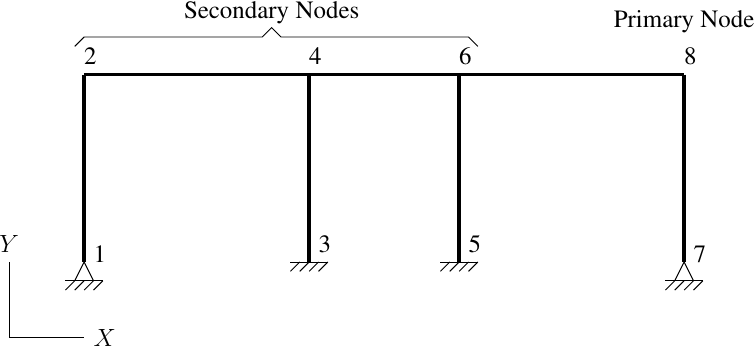OpenSees Cloud
OpenSees AMI
Rigid Diaphragm for 2D Models
Original Post - 05 Nov 2022 - Michael H. Scott
Show your support at Buy Me a Coffee.
The rigidDiaphragm command allows you to constrain
the motion of multiple secondary nodes to the motion of a primary node,
e.g., when simulating rigid floor diaphragms in 3D structural models.
But what if you want to enforce rigid diaphragm constraints for a 2D model, e.g., as shown below?

Prior to PR #764,
you would have been out of luck with the rigidDiaphragm command. But
there was an easy work around of looping over the secondary nodes and
calling the equalDOF command.
for nd in [2,4,6]:
# primary secondary DOF
ops.equalDOF(8, nd, 1)
With PR #764,
the rigidDiaphragm command works for 2D models. Specify the DOF to
constrain, followed by the primary node then the secondary nodes.
# DOF primary secondaries
ops.rigidDiaphragm(1, 8, *[2,4,6])
Similar to how the 3D rigidDiaphragm command checks that the primary
and secondary nodes lie in the same global X-Y, Y-Z, or X-Z
plane, the 2D version makes sure the nodes have the same Y or X
coordinate (Y for constrained DOF 1, X for DOF 2).
A single rigidDiaphragm command is functionally no different from
calling equalDOF several times–behind the scenes, rigidDiaphragm
creates a separate MP_Constraint object for each secondary node.
The big improvement is conceptual, as many folks who use the equalDOF
command to create rigid diaphragms in 2D think they can also construct
rigid diaphragms in 3D using equalDOF constraints in two orthogonal
directions–torsion be damned. Start with rigidDiaphragm in 2D so that
you don’t mistakenly over-constrain your model when you go 3D.